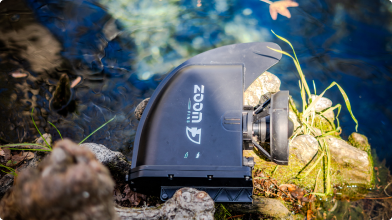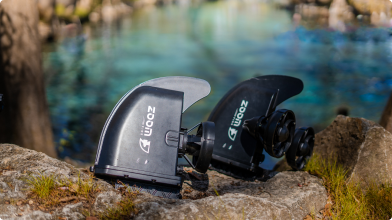
Breaking the Myths: Common Misconceptions About Motorized Fins
Motorized fins have gained attention in the stand-up paddleboarding (SUP) community for offering an extra boost in choppy waters or against stubborn headwinds. Along with all the excitement, though, come various rumors and myths, some based on outdated information and others that might be pure speculation. If you’ve been curious about motorized fins but aren’t quite sure what to believe, the following Q&A addresses the most common concerns.
Q1: Aren’t Motorized Fins Bulky and Hard to Carry?
Answer:
This used to be a valid concern years ago when motorized water gear was often heavy. Modern motorized fins, however, use lightweight materials such as carbon fiber or rugged plastics, making them surprisingly easy to transport. Many models fit right into a standard fin box on a paddleboard. The battery packs are also slimmer these days, so you can usually tuck them into a small backpack.
The Bottom Line:
Weight and bulkiness aren’t the obstacles they once were. With recent innovations, most motorized fins add only a few extra pounds, which is hardly noticeable once you’re out on the water.
Q2: Will a Motorized Fin Ruin the “Pure” Paddleboarding Experience?
Answer:
Some enthusiasts worry that adding a motor strips away the essence of SUP. Yet, most motorized fins are designed to enhance your experience rather than overshadow it. The choice remains yours: you can paddle just as you always have, engaging the motor only when faced with strong currents, long distances, or a desire to conserve energy. You’re still in full control steering, balancing, and deciding if and when to engage the motor.
The Bottom Line:
A motorized fin doesn’t replace the art of paddling. It’s like having extra gear on your bicycle: you still get a workout and maintain your connection with the water, but you have backup when you need it.
Q3: Are Motorized Fins Noisy or Harmful to Marine Life?
Answer:
Many people assume that “motorized” equals “loud and disruptive.” However, most fins on the market use quiet electric motors, which produce only a gentle hum. This is far less intrusive than the roar of gas-powered boat engines. Marine life is typically less affected by such minimal noise, and electric propulsion avoids direct emissions in the water.
The Bottom Line:
Electric motors are comparatively gentle in aquatic environments. They allow you to explore lakes, rivers, or coastal areas without the disturbance or pollution associated with traditional fuel-powered engines.
Q4: Are These Devices Complicated to Install and Maintain?
Answer:
No one wants to spend precious time ashore fumbling with a complicated setup. Fortunately, motorized fins are usually installed much like any standard SUP fin. You slide the fin into the fin box and secure it, then connect the battery. Maintenance mostly involves rinsing everything with fresh water after each use (especially if you’ve been in saltwater) and checking that the battery terminals stay clean and dry.
The Bottom Line:
If you can handle a standard paddleboard setup, you can install a motorized fin. Routine care is similar to looking after any other piece of SUP gear.
Q5: Won’t Using a Motor Make Me Lazy?
Answer:
There’s a notion that motor assist means you’re cheating or taking shortcuts, but that overlooks how and why people actually use these fins. For some, it’s about tackling longer distances without exhausting themselves. For others, it’s peace of mind when facing unpredictable winds or currents. You’re still standing, balancing, and often paddling. The motor doesn’t do all the work; it just helps you go further or feel more confident under challenging conditions.
The Bottom Line:
A motorized fin doesn’t transform paddleboarding into a passive experience. You’re still actively engaged. Think of it as an optional assist that can help you paddle smarter, not lazier.
Q6: What If the Battery Dies in the Middle of the Water?
Answer:
Battery life varies by model, but many fins can run for hours at moderate speeds on a single charge. Plus, a built-in display or simple battery indicator often lets you know when you’re running low. If the battery does happen to die mid-session, you’re still on a functional paddleboard you can keep paddling normally until you reach shore.
The Bottom Line:
Running out of power doesn’t leave you stranded. The board remains fully operational as a standard SUP. You can also carry a spare battery if you plan an extended trip or want an additional safety net.
Q7: Are Motorized Fins Costly to Operate?
Answer:
An electric motorized fin involves an upfront cost, but daily use expenses are minimal. You’ll need to recharge the battery, but that’s essentially the only recurring cost: there's no gasoline to buy and no specialized engine maintenance. Occasional part replacements (like propellers) might be required, but these tend to be straightforward and relatively inexpensive.
The Bottom Line:
After the initial investment, operating costs for a motorized fin are low. You mostly have to keep it charged and give it routine cleaning, making it a budget-friendly option in the long run.
Q8: How Steep Is the Learning Curve?
Answer:
People often wonder if they have to learn an entirely new way to steer or balance. In most cases, you’ll paddle and maneuver just as before. A small remote or control switch adjusts the motor speed or switches it off. The subtle push from the motor doesn’t alter your fundamental SUP technique. After a quick trial, most paddleboarders become comfortable with the motorized setup.
The Bottom Line:
If you’re already comfortable on a paddleboard, you likely won’t need much time to master a motorized fin. The transition is smooth, allowing you to focus on enjoying the water.
Conclusion
Motorized fins are more than just a trendy gadget; they’re a versatile tool that can expand your stand-up paddleboarding horizons. While misconceptions abound ranging from weight and noise worries to fears of losing authenticity the truth is far more reassuring. These fins are lightweight, quiet, environmentally friendly, and user-friendly. They don’t replace the skill and joy of paddling; they offer a helpful boost when you want or need it.
If you’ve been sitting on the fence due to outdated myths, consider giving a motorized fin a try. It may just open up new routes, longer adventures, and fresh confidence for your next SUP outing. In the end, it’s all about enjoying more time on the water exactly the way you want. Safe paddling!




